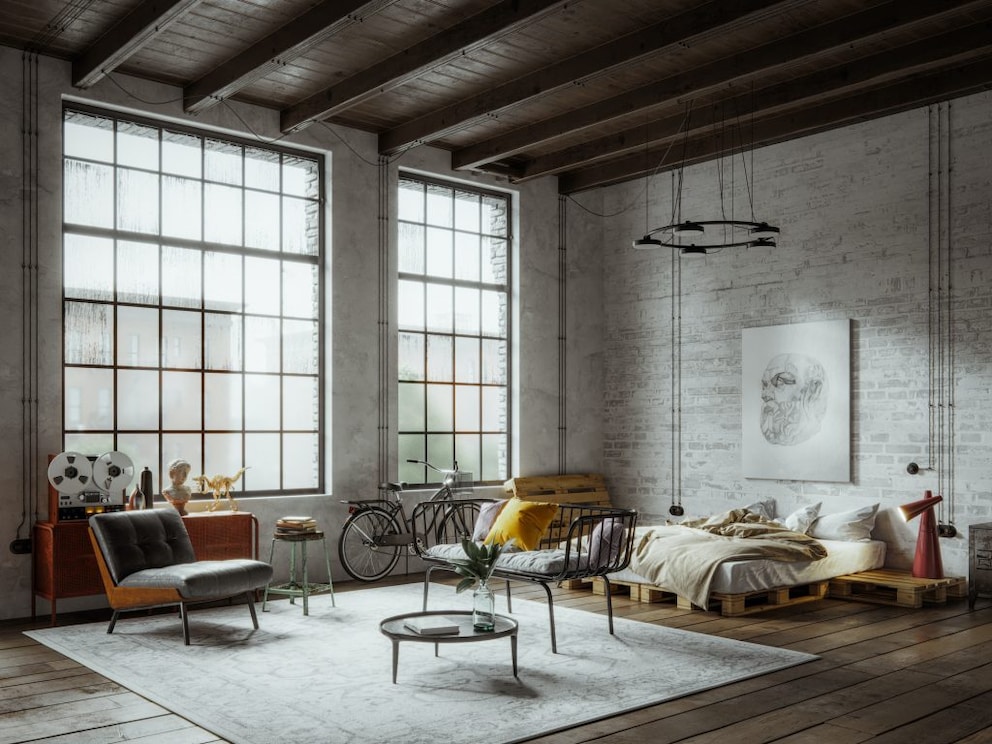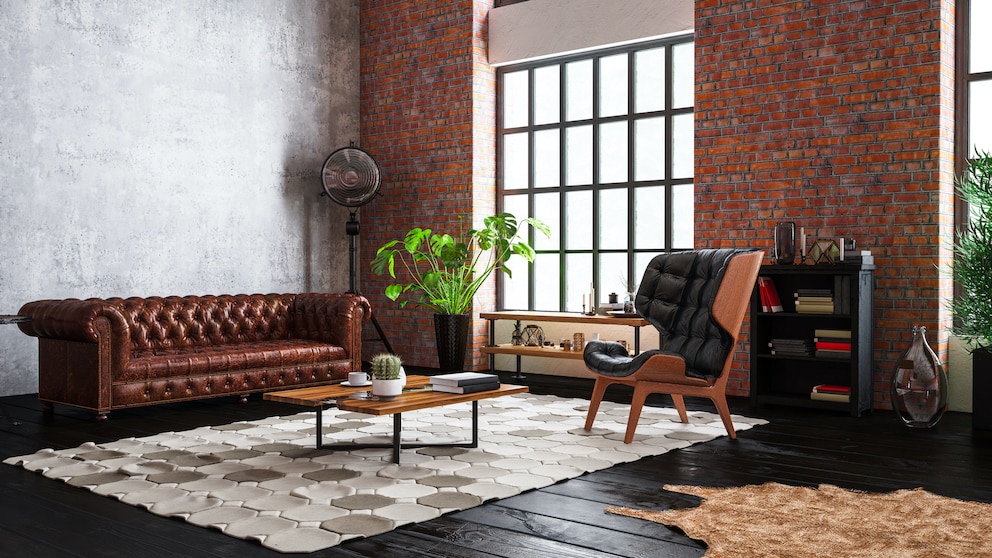March 20, 2025, 8:04 pm | Read time: 5 minutes
When we think of industrial style, we think of old factory buildings and open, studio-like lofts in Brooklyn. There’s good news for fans of the raw look: You don’t necessarily have to go apartment hunting in New York to bring the industrial aesthetic into your home. myHOMEBOOK shows you how to recreate the style with ease.
Exposed brickwork, steel, and exposed concrete — the industrial style looks rough, striking, and cool. An industrial-inspired interior has a unique charm. Whether it’s an urban loft or an old farmhouse, the style can be implemented in almost any home. We explain how it works.
Overview
Industrial Style: What Is It?
Industrial refers to an interior design style that — as the name suggests — is strongly oriented towards buildings used for industrial purposes. The industrial style is characterized by a rough aesthetic reminiscent of factory halls and an open, loft-like apartment layout, for which the New York borough of Brooklyn and London’s East End are particularly well-known.
The industrial style is also characterized by its imperfect look: Exposed brickwork, flaking plaster, striking steel beams or ceiling joists, visible pipes, or worn floors — all of this is intentional and adds to the special charm.
Dark steel is an absolutely key element in industrial interiors, for example, in the form of oversized factory windows, partition walls made of glass and black steel, or matt lacquered metal cabinets. The color scheme is also generally characterized by dark, rough tones such as black, anthracite, brown, or rusty red.
Floor coverings that match the industrial style are concrete or screed, as well as robust floorboards that can creak. If you’re wondering whether the floor is right for you, simply do the shoe test: ask yourself whether you would walk barefoot on this floor. If the answer is no and you tend to wear street shoes, then you are on the right track.
Of course, this doesn’t mean that the industrial style has to turn your clean and comfortably furnished home directly into a worn-out factory floor. There are many shades between a hygge paradise and a tough loft with an extreme industrial look. For example, a cozy old apartment can be given a cool touch with just a few industrial elements without the home having to lose any of its warmth.
Where Does the Industrial Style Come From?
The industrial style originated in the 1940s. As affordable living space became scarce in the USA and Great Britain, some individuals began transforming vacant industrial halls into livable lofts. During the artist movement of the 1960s and 1970s, an increasing number of creatives embraced the industrial aesthetic, repurposing factory buildings, warehouses, and similar structures into studios and loft apartments. Andy Warhol is considered a pioneer with his Factory.


Rest and relaxation Furnishing tips for a Zen-style bathroom

Interior Designer Presents These Are the Garden Furniture Trends for 2025

"Mocha Mousse" How to Beautify Your Home with the Trendiest Color of 2025
5 Characteristics of the Industrial Style
1. Open Spaces
The industrial style is naturally at home in a classic loft. High ceilings, an exposed roof truss, and, of course, the open room layout create an unmistakable factory hall aesthetic.
Of course, if you don’t have a loft available, you don’t have to move straight away. The industrial charm is also a good fit for loft apartments. Ideally, gables, support beams, or roof beams should be visible. An open kitchen and generally open spaces complement the aesthetics. But don’t worry: the industrial style can easily be incorporated into any home without having to meet certain basic requirements.
2. Heavy, Straight-Lined Sofas
White plush has no place in industrial style. The ideal sofa style is straightforward and angular. Dark colors, smooth structures, and an overall heavy and robust design suit the look. The top choice for an industrial look? A brown leather Chesterfield sofa.
3. Black Steel
Black steel belongs to the industrial style like the Oktoberfest belongs to Munich. This is due to the characteristic high windows made of glass and steel that were used in the original factory buildings. Although some lofts are still fitted with such windows, the look is usually rather difficult to find. However, this is no cause for disappointment. Instead, industrial fans can simply opt for metal shelving or furniture with black steel legs. For a truly authentic look, consider installing partitions made of glass and black steel.
4. Exposed Brickwork
Rough brick or tile walls are an absolute must-have for the industrial style. If you really embrace the look, you can expose the entire brickwork. Particularly visually interesting: only remove the plaster in a few places. This creates a weathered, rough appearance, giving the impression that the plaster has naturally crumbled off the wall.
The only drawback: exposing the brickwork is labor-intensive and typically feasible only in condominiums. If you don’t have the fortune of finding a rental with brick walls, there are other accessible solutions. Textured wallpaper with a brick look, for example, can be used to cover either the entire wall or parts of it. These wallpapers are available in high-quality versions that make them nearly indistinguishable from real brick.
Tip: If you don’t fancy brick walls, you can opt for the concrete look, which goes just as well with the industrial style. The same applies here as for brickwork: exposed concrete walls can be easily imitated with wallpaper in the same look.
5. Furniture with Signs of Wear and Tear
Patina is the keyword: if the furniture looks a little weathered, rough, and used, it is just right for the industrial style. Striking tables made of rough solid wood are ideal. The table legs should be made of heavy metal or steel and make a heavy, robust impression. A wooden top with cracks and blemishes complements the industrial look. For lacquered furniture, it’s acceptable for the lacquer to show some peeling. Even if these elements are slightly reminiscent of vintage or shabby chic, the industrial style is still fundamentally different from these types of furnishings. While the latter has a more romantic feel, industrial is characterized by coolness. Overall, the interior should embody a raw, cool, and tough aesthetic — infused with just the right dose of factory charm.

